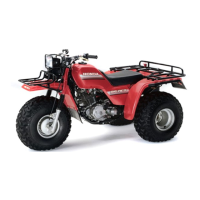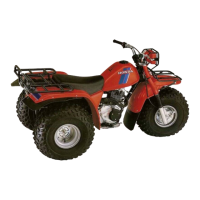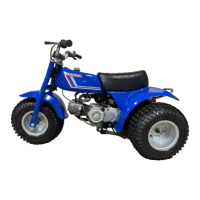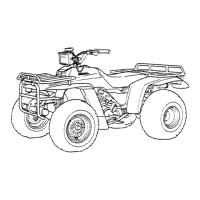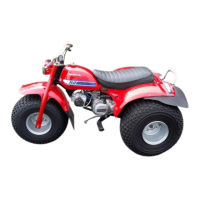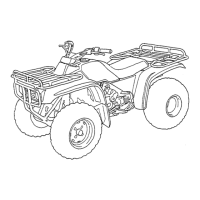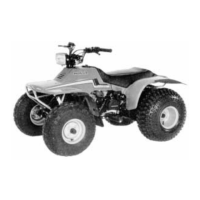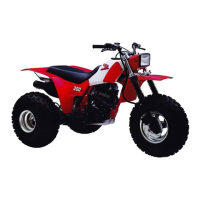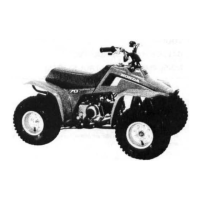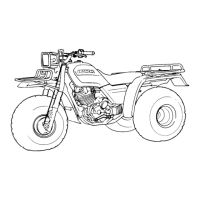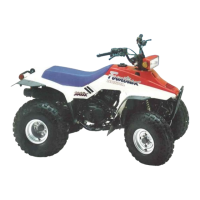
Do you have a question about the Honda 1987 FOUR TRAX 200SX and is the answer not in the manual?
| Brand | Honda |
|---|---|
| Model | 1987 FOUR TRAX 200SX |
| Category | Offroad Vehicle |
| Language | English |
Key warnings for safe operation including tire pressure, load limits, and starting procedures.
Safety guidelines covering passenger use, supervision, off-road operation, protective gear, and substance avoidance.
Essential rules for safe riding including pre-ride checks, obeying laws, terrain awareness, and protective apparel.
Information on vehicle modifications, exhaust system, and post-ride cleaning and inspection procedures.
Guidelines for safely loading accessories and cargo, including weight capacity and placement recommendations.
Notes regarding optional carriers, avoiding cargo obstruction, and the vehicle's passenger carrying limitations.
Illustrates and labels the main external parts of the Four Trax for easy identification.
Continues part identification, focusing on handlebar controls and other operational components.
Explains the location of frame and engine serial numbers for parts ordering and reference.
Details the function of the ignition switch based on key positions and key removal.
Explains the reverse indicator lamp and the operation of the engine stop switch.
Describes the function of the starter button and headlight switch/dimmer.
Details the location and purpose of the owner's manual and general storage compartments.
Explains the location and proper use of the helmet holder for securing a helmet while parked.
Describes the operation of the throttle lever and the rear brake lever, including its parking brake function.
Explains how to use the reverse selector knob and identify neutral status via indicator lamps and marks.
Details the function of the decompressor lever for starting and the choke knob for cold engine starting.
Explains how to use the gearshift pedal for shifting gears and engaging reverse.
Provides instructions and warnings for replacing the main fuse, emphasizing safety.
Describes the function of the three-way fuel valve (ON, OFF, RES) for managing fuel supply.
Details fuel tank capacity, gasoline type, and proper use of the fuel tank cap and vent lever.
Advises on using gasohol, octane ratings, and potential issues with alcohol-based fuels.
Instructions on checking engine oil level using the dipstick and maintaining the correct level.
Recommends oil types, API service classification, and provides viscosity recommendations based on temperature.
Lists tire sizes, brands, and recommended inflation pressures for front and rear tires.
Advises on tire maintenance, flat repair, and checking tread depth for safe operation.
Explains battery type, care for weak batteries, and proper storage procedures to prevent damage.
Lists essential checks before riding to ensure safety and prevent equipment failure or accidents.
Outlines preparation steps before starting the engine, including surface, parking brake, and neutral verification.
Detailed procedures for starting the engine under normal and high air temperatures, including choke use.
Starting procedures for low temperatures and instructions for using the recoil starter.
Instructions for clearing a flooded engine and guidelines for proper engine break-in.
Fundamental riding advice, including safety review, avoiding stunts, and basic gear shifting.
Instructions for safe operation in reverse, including throttle control and braking to avoid accidents.
Explains techniques for turning, weight shifting, and throttle control for optimal traction and stability.
Discusses handling skids on various surfaces and the importance of surface awareness for control.
Provides techniques for safely climbing hills, emphasizing weight transfer and throttle control.
Advises on safe downhill riding and mastering level-ground turns before attempting hills.
Guides on descending slopes safely, including proper braking and avoiding sharp angles.
Explains maintaining balance on slopes, leaning uphill, and steering for course stability.
Precautions for riding through water, including depth limits, stream crossing, and post-water brake checks.
Instructions for cleaning front brakes after riding through mud.
Advises on operating at high altitudes and potential carburetor adjustments.
Details steps for safe parking, including securing the brake and avoiding inclines.
Outlines required maintenance tasks and their corresponding service intervals (initial and regular).
Lists further maintenance items like drive chain, brakes, and suspension with their service frequencies.
Lists tools provided for routine maintenance and simple repairs.
Step-by-step instructions for draining and refilling engine oil, emphasizing warm engine and correct level.
Guides on removing, cleaning, and reinstalling the oil strainer screen, including torque specifications.
Instructions for servicing the centrifugal oil filter, including cleaning and reinstallation.
Details how to remove, clean, and reassemble the fuel strainer screen to ensure proper fuel flow.
Explains how to adjust idle speed and fuel mixture using throttle stop and air screws.
Discusses how high altitude affects the air-fuel mixture and performance.
Step-by-step guide for modifying carburetor jetting for high altitude operation.
Instructions for inspecting, gapping, and tightening spark plugs, with safety cautions.
Details cleaning the air cleaner element and soaking it in gear oil.
Guides on checking and adjusting valve clearance, including timing marks and adjuster settings.
Continues valve adjustment, focusing on lock bolts and specified clearance settings.
Explains how to adjust the clutch for proper operation by adjusting slack.
Instructions for draining deposits from the air cleaner case drain tube.
Covers checking front brake lever free play and inspecting brake shoe lining thickness.
Details front brake adjustment, bleeding air, and maintaining brake fluid level.
Advises on using correct brake fluid, handling it carefully, and performing system checks.
Explains rear brake pedal free play adjustment and checking brake cable condition.
Details rear brake lever free play adjustment and wear indicator check.
Guides on inspecting, lubricating, and adjusting throttle cable free play.
Explains drive chain adjustment, lubrication, and cleaning procedures.
Instructions for periodically purging the spark arrester of accumulated carbon.
Details measuring and adjusting free play for the reverse selector lever.
Advises checking under guard and skid plate for damage or looseness.
Steps for storing the vehicle long-term to minimize deterioration, including oil changes and fuel draining.
Instructions for preparing the vehicle after storage, including cleaning, battery check, and pre-ride inspections.
Outlines precautions for transporting the vehicle, such as draining fuel and securing the battery.
Provides instructions for removing and installing wheels, including torque specifications.
Lists key dimensions like length, width, height, wheelbase, and capacities for oil, fuel, and passengers.
Details engine specs (bore, stroke, compression) and chassis/suspension geometry.
Presents the complete wiring diagram showing electrical component connections.
Advises owners on resolving vehicle issues by contacting the dealer and customer relations.

